A whole lot of nothing
Larry Rudnick looked wide into outer infinite and saw—nothing. The discovery thrilled him.
"I came home, sat at the dinner table, and told my wife, 'We recovered something pretty exciting now,'" says Rudnick, an stargazer at the University of Minnesota, Similitude Cities.
What he found was the biggest sweep of nothing e'er ascertained. Inside the invalidate, in that location are hardly any galaxies, planets, or black holes—just mostly empty blank spanning an area that's a billion Christ Within-years across.
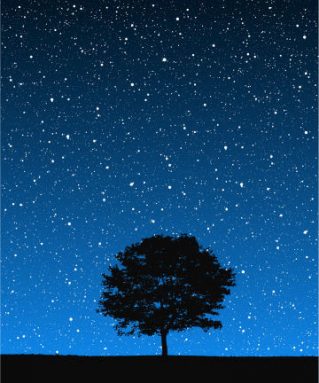 |
| Stars and different objects fill in most of the universe, only scientists were dumbstruck freshly to find a huge area of mostly empty space. |
| iStockphoto.com |
To begin a signified of how big that is, ideate slack outdoors happening a night when the Sun Myung Moon is full. Note how much space the moon takes up. The newly discovered void is 40 times as wide atomic number 3 the full moon from our view.
The find of so much nothingness helps explicate about mysteries about the macrocos, Rudnick says. Simultaneously, the newly ascertained void raises new questions about how galaxies, stars, planets, and former structures formed.
For a long time, astronomers thought that matter—which makes up everything in the universe—was thin fairly evenly through space, with only lilliputian ransacked spaces and small spider-weblike structures. The new observe calls that assumption into question.
"Something in the theory [about the organisation of social structure in the universe] might have to alteration," Rudnick says. In particular, the question of how matter has clumped together over time to form galaxies, planets, and other objects is at one time to a greater extent undefended to discussion.
"It's an important part of the chronicle of how we got hither," helium says.
A cold puzzle
Rudnick's discovery began with observations made by other scientists close to something called cosmic microwave background radiation, or CMB. The CMB is a glow of energy—or radiation—that flooded outer space about 13.7 billion years ago, aft a huge, extremely stifling burst called the Big Hit brought about the shaping of the universe.
The CMB still fills the universe, but it has changed. For one thing, it has drastically cooled. Evenhanded after the Big Bang, the radiate was billions of degrees thermal. Immediately, says Rudnick, information technology is just 3 degrees above zero point kelvin (K). That's equal to -454 degrees Fahrenheit Beaver State -270 Celsius. Nil K is called "absolute zero." And you bottom't get any colder than that.
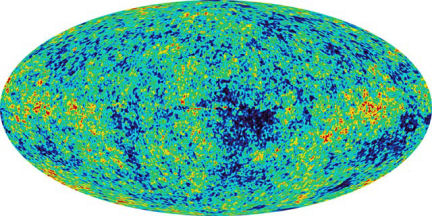 |
| This "mollycoddle characterization" of the universe shows the oldest light in the universe, produced just 379,000 years after the Bulky Bang, which occurred more than 13 billion years ago. "Warmer" areas look red. "Ice chest" areas look blue. This was the first full-sky map of its merciful and was made with data collected by the WMAP outer. |
| NASA |
Calculations show that about of the radiation is about the duplicate temperature in all directions. In the scientists' words, it's "smooth."
But not perfectly smooth. The CMB has small irregularities that are odd from more or less the time of the Big Bang. These irregularities let in small muscae volitantes that are slightly hotter operating theatre colder than average.
About three old age past, scientists made a puzzling reflection that they couldn't explain. In the CMB radiation, they detected a cold spot that was especially intense.
They saw the shivery spot in images taken away the Wilkinson Microwave Anisotropy Probe planet. The satellite has been orbiting Earth since 2001 and scientists have been using it to map the Cosmic background radiation.
Always since the discovery of that extracold cold spot, scientists have been debating its import. Because the CMB formed just after the parentage of the universe and has been ever-changing ever since, an oddity in combined part of the radiation points to either "something very funny in that spot from the early creation operating theatre something funny that happened on the way," Rudnick says.
Rudnick was working on a completely different project when he first detected about the supercold cold spot. He was feeling frustrated with his research, and his mind kept straying to the new mystery.
"I decided to look in the direction of this cold spot," Rudnick says, "and see what I could see."
Radio clues
To get a closer look, Rudnick looked at pictures of the position taken by the Very Large-mouthed Array (VLA), a radio telescope in Land of Enchantment. Receiving set telescopes are huge, dish-wrought structures that collect radio waves, which fundament be converted into images that reveal details we fundament't see with our eyes alone.
A small fraction of galaxies in the universe, for example, return off strong radio waves, Rudnick says. These galaxies, called radio galaxies, are shared fairly evenly through space.
When He examined the VLA images, however, Rudnick counted 30 percent to 40 percent less radio galaxies than normal in the focal point of the cold spot. Stuck, helium turned to University of Minnesota calibrate student Shea Brown and astronomer Lilya Williams for sixth sense.
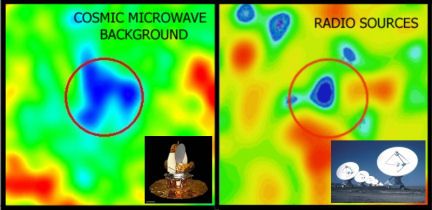 |
| Rudnick and colleagues found the void by comparing two views of the same region of sky, shown above. Inside the circle on the left is a large cold spot detected by the WMAP artificial satellite (inset). The image happening the right shows a lower than average number of radio galaxies in the same orbit, as seen by a radio telescope named the VLA (inset). |
| Rudnick et al., NRAO/AUI/NSF, National Aeronautics and Space Administration |
The but explanation for the unexpectedly abject number of radio galaxies in the funnily glacial spot, the team decided, was that the spot was actually a huge expanse of empty space. Rudnick and his colleagues think that most of the remaining galaxies seen in the way of the cold spot believably lie in front of or behind the void.
Their reasoning went like this: All over billions of years, clumps formed in the topic of the universe, like cheese curds form in a vat of souring milk. (See "A Taste for Cheese") Those compact, clumpy areas gave rise to planets, stars, galaxies, and other objects.
In these areas of higher density, the CMB becomes slightly hotter than average. But the clumping too left some areas with less matter and little density. In these areas, the CMB becomes slightly colder than average—which probably explains the extreme point coldness of the recently discovered cold spot.
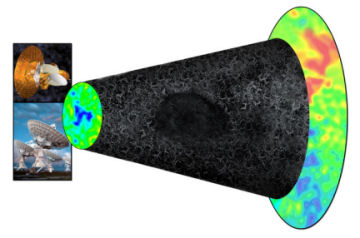 |
| This exemplification represents the CMB radiation moving through the cosmos, and changing temperature on the way—from the Braggy Bang on the immoderate right, through and through a spider web of galaxies and clusters of galaxies, to us and our telescopes on the far left, which observe a polar spot (shown in blue). In the center of the diagram is a queen-size void. |
| Government note Saxton, NRAO/AUI/NSF, NASA |
Astronomers already knew that low-density holes existed in the universe. But, at a cardinal incandescent-years across, this was by far the biggest vitiate ever disclosed.
To get a sense of how much bigger this void is than any other known holes, imagine exploring the surface of Earth, where only a few mountains top 20,000 feet (6,000 meters).
"If all of a sudden, you stumbled across a mountain that was 100,000 feet high, you'd go, 'Oh my gosh, where did this descend from?'" Rudnick says.
"You might enounce, 'Scientists mentation they understood how mountains were reinforced, but can they explicate this uncomparable?'" he adds. "That's exactly what we're request here" about the big void.
Clean explanations
To explain the being of the frosty spot, Rudnick says, scientists in years past had proposed theories that involved "strange things going on in the early universe."
Convinced that the cold spot formed honourable after the Big Bang, these scientists didn't even consider that information technology might be a huge hole that developed over prison term. But a big hole is a much simpler resolution than the complicated theories scientists previously proposed.
"It's an explanation for something that was odd," says Ned Richard Wright, an astrophysicist at the University of California, Los Angeles. "It's an interesting result."
Questions still remain. Supported what scientists know about bodily structure formation in the universe, in that location should be simply a 1 in 100,000 casual of finding a void this large, Rudnick says. So why is it there?
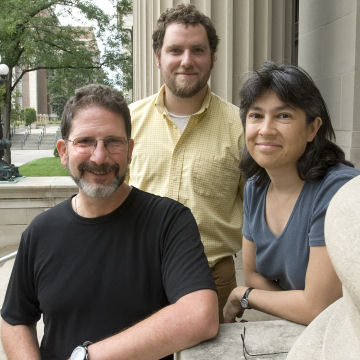 |
| Awhile, Larry Rudnick (left-wing), Shea Brown, and Lilya Williams were the only scientists in the world World Health Organization knew virtually the overlarge void. |
| Patrick O'Leary |
Figuring tabu how this huge void formed could help us better understand how the universe and its structures formed. Related research might help explicate how mysterious substances known as dark matter and dark energy interact with ordinary matter in space. (See "Eery Universe: The Stuff of Darkness")
But that's not all. Foster work could also show how far away the void is and whether it's wrought like a ballock, a cigar, or something else, Wright says. It's also not clear whether the void is totally plundered, of if there is fitting some less matter there than expected.
Other scientists need to support Rudnick's results. But for now, Rudnick is glowing from his ain good sense of discovery.
When he, Brown, and Williams patterned exterior what they were sounding at, the enormity of the discovery was exhilarating. "We were the only three people in the whole world that knew there was a hole there," he says.
"That's such an exciting moment to know that no one in the whole world knows what you know," he says. "That's one of the first parts of scientific discipline. IT doesn't get any amended than that."
Going Deeper:
Additional Information
Questions about the Article
Word Discovery: The Big Void

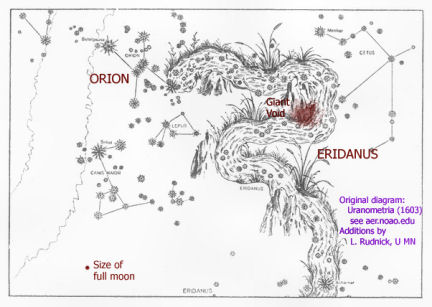
0 Response to "A whole lot of nothing"
Post a Comment